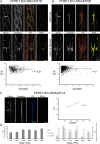Association of microtubules and axonal RNA transferred from myelinating Schwann cells in rat sciatic nerve
- PMID: 32469980
- PMCID: PMC7259579
- DOI: 10.1371/journal.pone.0233651
Association of microtubules and axonal RNA transferred from myelinating Schwann cells in rat sciatic nerve
Abstract
Transference of RNAs and ribosomes from Schwann cell-to-axon was demonstrated in normal and regenerating peripheral nerves. Previously, we have shown that RNAs transfer is dependent on F-actin cytoskeleton and Myosin Va. Here, we explored the contribution of microtubules to newly synthesized RNAs transport from Schwann cell nuclei up to nodal microvilli in sciatic nerves. Results using immunohistochemistry and quantitative confocal FRET analysis indicate that Schwann cell-derived RNAs co-localize with microtubules in Schwann cell cytoplasm. Additionally, transport of Schwann cell-derived RNAs is nocodazole and colchicine sensitive demonstrating its dependence on microtubule network integrity. Moreover, mRNAs codifying neuron-specific proteins are among Schwann cell newly synthesized RNAs population, and some of them are associated with KIF1B and KIF5B microtubules-based motors.
Conflict of interest statement
The authors declare that there is no conflict of interest regarding the publication of this article.
Figures




Similar articles
-
4S RNA is transported axonally in normal and regenerating axons of the sciatic nerves of rats.Brain Res. 1981 Dec 28;230(1-2):181-94. doi: 10.1016/0006-8993(81)90400-5. Brain Res. 1981. PMID: 6172181
-
Beta 4 integrin expression in myelinating Schwann cells is polarized, developmentally regulated and axonally dependent.Development. 1994 May;120(5):1287-301. doi: 10.1242/dev.120.5.1287. Development. 1994. PMID: 8026337
-
Induction of myelin genes during peripheral nerve remyelination requires a continuous signal from the ingrowing axon.J Neurosci Res. 1993 Jan;34(1):14-23. doi: 10.1002/jnr.490340103. J Neurosci Res. 1993. PMID: 7678657
-
The effect of myelinating Schwann cells on axons.Muscle Nerve. 2001 Apr;24(4):456-66. doi: 10.1002/mus.1027. Muscle Nerve. 2001. PMID: 11268016 Review.
-
Glia to axon RNA transfer.Dev Neurobiol. 2014 Mar;74(3):292-302. doi: 10.1002/dneu.22125. Epub 2013 Nov 4. Dev Neurobiol. 2014. PMID: 23997031 Review.
Cited by
-
Central Alteration in Peripheral Neuropathy of Trembler-J Mice: Hippocampal pmp22 Expression and Behavioral Profile in Anxiety Tests.Biomolecules. 2021 Apr 19;11(4):601. doi: 10.3390/biom11040601. Biomolecules. 2021. PMID: 33921657 Free PMC article.
-
Age-dependent increase of cytoskeletal components in sensory axons in human skin.Front Cell Dev Biol. 2022 Nov 1;10:965382. doi: 10.3389/fcell.2022.965382. eCollection 2022. Front Cell Dev Biol. 2022. PMID: 36393849 Free PMC article.
-
Functional Genomics of Axons and Synapses to Understand Neurodegenerative Diseases.Front Cell Neurosci. 2021 Jun 25;15:686722. doi: 10.3389/fncel.2021.686722. eCollection 2021. Front Cell Neurosci. 2021. PMID: 34248504 Free PMC article. Review.
-
Cross Talk at the Cytoskeleton-Plasma Membrane Interface: Impact on Neuronal Morphology and Functions.Int J Mol Sci. 2020 Nov 30;21(23):9133. doi: 10.3390/ijms21239133. Int J Mol Sci. 2020. PMID: 33266269 Free PMC article. Review.
-
The functional organization of axonal mRNA transport and translation.Nat Rev Neurosci. 2021 Feb;22(2):77-91. doi: 10.1038/s41583-020-00407-7. Epub 2020 Dec 7. Nat Rev Neurosci. 2021. PMID: 33288912 Free PMC article. Review.
References
Publication types
MeSH terms
Substances
LinkOut - more resources
Full Text Sources
Miscellaneous

